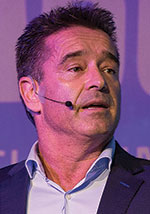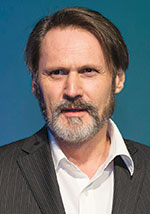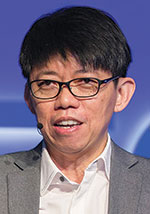
NEC XON hosted its annual summit in October 2019 at Sun City under the banner of ‘Orchestrating a Brighter World’. The conference was supported by sponsors who each had displays in the exhibition area where they interacted with delegates over the course of the day.

NEC XON CEO, Carel Coetzee, launched the proceedings with a video describing how technology can and is enhancing the lives of people around the world, including those in rural areas in Africa. And Africa was a prime focus of the conference, with multiple presenters noting it is on the brink of some significant opportunities when considering the latest technologies available to organisations and people, as well as other changes that are occurring at the moment.
One of the opportunities is the African Continental Free Trade Agreement (ACFTA), for which 54 countries have already signed up. Once in effect, this will provide for a single continental market for goods and services, as well as free movement for business people and investments. But Coetzee added that this is only one of a number of transitions that will have a significant impact on Africa over the next 30 years. He said NEC XON is in a prime position, along with its partners, to be part of this opportunity to really orchestrate a brighter future for all.

The future has happened
Coetzee was followed by Pieter Geldenhuys, director at the Institute for Technology Strategy and Innovation. Geldenhuys was on hand to provide a perspective on what the future would look like, globally and closer to home. He explained that defining what the future is was only the first step and that organisations, individuals and countries must make preparations to succeed in that future.
One of the areas he covered was demographics and the challenges facing most countries as their birth rates decline and people live longer. In almost all countries, including China, Russia, USA and most European states, there will be a decline in the number of young people as a percentage of the population over the next 20 to 40 years. This will have a significant impact on consumption economies since it is the 20- and 30-somethings that spend the most.
South Africa, on the other hand, will be in a healthier situation with a more evenly distributed population (distributed according to age), as the country has more young people to boost its economy. Africa itself is the only continent he expects to have an increasing population through to 2100, with all other continents’ populations levelling out or declining. However, simply having the numbers of people will not make much of a difference if the continent (and South Africa) is not prepared, which includes ensuring the right skill levels are attained and available.
Geldenhuys went on to examine geopolitics, with the highlight being the challenges to free trade if the USA no longer continues its free-trade drive. He also touched on China’s One Road, One Belt ambitions to secure its supply chain. The results of this could be less free trade agreements, which could be bad for some and good for others, depending on how organisations and countries align themselves.
In looking at economic trends, however, the current state of debt all around the world is a crisis that will not end well. The USA is the prime candidate for trouble in this respect, but the rest of the world has nothing to crow about as the global debt stands at over $240 trillion.
The future of technology is far more exciting, however. We are now in the end stages of the fifth wave of technology disruption driven by information technology such as networks, software and new media – which will be marked by a slowdown before the next wave takes off. However the sixth wave will create significant changes over the next 20 to 40 years. (Readers may wish to read up on the concept of ‘Creative Destruction’.)

The next decade
Walter Lee, evangelist and government relations leader in the global safety division of NEC Corporation, took the stage after Geldenhuys to focus in on a few of the technologies that are going to make a significant impact in the next decade. Lee touched on a variety of subjects, such as the importance of 5G networks, the Fourth Industrial Revolution (4IR), artificial intelligence (AI) and the convergence of cyber and physical security. This will result in the development of ‘Integrated & Intelligent Operations Centres’, which will manage the security and operations for a broad range of environments, from border control to city surveillance. NEC XON already has a few of these operating in Africa.
As far as 5G is concerned, he said this is not simply another network technology, but will have an impact on everything, from business to society. With it we are truly heading into a world where everything is connected, potentially at less cost than ever. Of course, security is a critical aspect of this connected world and must be built into the architecture of all services and solutions.
Moreover, 5G will allow security providers to connect more sensors to the network for broader coverage and also create opportunities for service providers to offer customers many value-added services. Lee says the era of 5G will transform what we think of as the Internet of Things (IoT) into the Internet of Everything (IoE).
AI is also a game changer and we will see more being done by intelligent algorithms than ever before, enhancing efficiency and accuracy. However, he believes that people will still play a major role in the mix as humans are still able to handle certain tasks better than AI.
Lee added that privacy would also become more important than ever, with biometrics at the centre of identity management and authentication. Lee said that as technology becomes more personal, each individual’s identity would become more powerful (and reliable and secure). Importantly, he believes, the power of one’s identity will remain in the hands of individuals and not be usurped by powerful corporations.

Continent of opportunity
Closing the conference, Eugene le Roux, chief executive of NEC XON Africa, said that Africa is in a good position to prosper in the future, a future that relies on young people to drive the agenda going forward. NEC XON sees huge potential on the continent and will use technology and its skills to contribute to the growth of the continent in various ways.
Two ways it can contribute and create social innovation include in the safety and security arena, as well as in the realm of efficiency and equality. The company will also be focusing on safe and smart cities, where it can contribute to security and safety in the areas of digital communications, personal security, infrastructure security and healthcare.
The company’s cybersecurity centres are already in operation in locations around the continent where digital assets are being kept safe around the clock. These centres deal with about 400 000 incidents per month and this number is only expected to grow. The key to their efficiency is that many functions are automated – such as patch management and remediation, among others – which allows for broad application in many scenarios, as well as leaving skilled people to handle more complex tasks.
On a personal level, the company believes biometrics – such as facial recognition – will enhance the safety of individuals across the continent, functioning as their identity verification mechanism, for example to access government services and their own health records.
Global partner of the year
At the summit it was announced that NEC XON won ADVA’s ‘Global Partner of the Year’ award. “This is a global OEM, recognising that a South African systems integrator is its top global partner,” says Anthony Laing, GM of networking at NEC XON. “It signals the level of solutions across the board that we’re capable of delivering to our customers based on the close, collaborative relationships we have with our OEM partners, who provide the best technologies in their sectors worldwide.”
The ADVA award celebrates NEC XON’s 125% year-on-year revenue growth, sales and business development through a broad presence and excellent customer relationships in Africa, its investment in ADVA technologies, and its capitalising on cross-selling opportunities into its large customer base.
“We strive to bring our customers innovative solutions that meet their practical needs,” says Laing, “like the network we created for the South African National Research Network (SANReN) that connects thousands of researchers, scientists and students across Africa.”
In May this year, NEC XON announced that it was deploying a national DWDM (dense wavelength division multiplex) network based on ADVA technology for SANReN, which is an initiative of the South African Department of Science and Technology hosted by the Council for Scientific and Industrial Research (CSIR). The deployment provides high-speed connectivity for research institutions, universities and other higher education institutions across the country.
The SANReN network consumes less energy and reduces truck rolls, which makes it an ecologically sound solution that delivers broadband connectivity for “researchers, educators and students, enabling them to push the boundaries of discovery and use advanced applications while collaborating with their peers in new ways”.
| Tel: | +27 11 237 4500 |
| Email: | [email protected] |
| www: | www.nec.xon.co.za |
| Articles: | More information and articles about NEC XON |
| Tel: | +27 11 543 5800 |
| Email: | [email protected] |
| www: | www.technews.co.za |
| Articles: | More information and articles about Technews Publishing |

© Technews Publishing (Pty) Ltd. | All Rights Reserved.